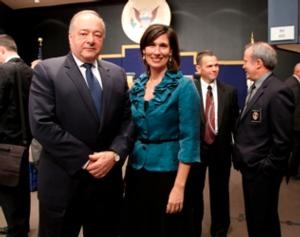Tue, Dec 06, 2011
HAI President Part Of NTSB Forum Held Last Week
The line between public use and civil aviation operations is
currently so blurred, especially for contract operators, that the
time has come to bring all the stakeholders together as a working
group to provide clarity on the issue. That was the message HAI
President Matt Zuccaro brought to the NTSB at its forum on public
use aviation safety.
(L-R) Zuccaro, NTSB Chair Hersman

Public use missions are flown for the public good by
government-owned or government-contracted aircraft. Some of the
better-known public missions include law enforcement, aerial
firefighting, search and rescue, and military.
For contract operators, especially, knowing which flights flown for
a government agency come under FAA jurisdiction and which are
public use and therefore outside of FAA oversight, is problematic.
But Zuccaro told the Board members that types of missions that
could not be accomplished under the FAA’s civil regulations
are few. He suggested that stakeholders gathered into a working
group should be able to narrowly define those missions and provide
recommendations about when an operator needs to declare that a
mission is public use and therefore beyond FAA oversight.
During testimony on another of the forum’s seven panels, HAI
Chairman of the Board Mark Gibson reiterated that point, telling
the board that many, if not most, of the operations that his
company, Timberland Logging, flies for government agencies, could
be flown under civil authorization. By law, public use aviation
missions are not considered part of civil aviation and therefore
not under the purview of the Federal Aviation Administration or
subject to most federal aviation regulations.
Under the FAA’s interpretation of the law, the government
agency operating or contracting for a public use mission assumes
the legal responsibility for the safe operation and maintenance of
that aircraft. Yet time and again over the course of the two-day
forum, agencies and contract operators alike said they operate
within the federal aviation regulations with only a few exceptions,
such as transporting hazardous materials or carrying Class D
external loads.
Zuccaro told the Board members that he feels strongly about the
need for a working group, and that if asked, would be willing to
sponsor the group.
More News
Outboard Section Of The Right Wing And The Right Flap Separated In Flight And The Airplane Impacted A Farm Field Analysis: The pilot was approaching his destination airport under i>[...]
Final Approach Fix The fix from which the final approach (IFR) to an airport is executed and which identifies the beginning of the final approach segment. It is designated on Gover>[...]
"Our choice of when to respond, how to respond and on which targets to respond is a consideration that we make every time... Netanyahu also noted that anyone attacking Israel &ldqu>[...]
Estimated (EST) When used in NOTAMs “EST” is a contraction that is used by the issuing authority only when the condition is expected to return to service prior to the e>[...]
Aero Linx: Coalition of Airline Pilots Associations (CAPA) The Coalition of Airline Pilots Associations (CAPA) is the world’s largest pilot trade association representing ove>[...]
 NTSB Final Report: Cessna 177B
NTSB Final Report: Cessna 177B ANN's Daily Aero-Term (05.08.25): Final Approach Fix
ANN's Daily Aero-Term (05.08.25): Final Approach Fix Aero-News: Quote of the Day (05.08.25)
Aero-News: Quote of the Day (05.08.25) ANN's Daily Aero-Term (05.09.25): Estimated (EST)
ANN's Daily Aero-Term (05.09.25): Estimated (EST) ANN's Daily Aero-Linx (05.09.25)
ANN's Daily Aero-Linx (05.09.25)



